- Author had a memorable travel experience, in and outside
train. Know about it day wise. Part 2 has cultural significance of places
visited, associated with Buddha, in Bihar/UP and Nepal. Recommend.
Earlier this month, I had free time and no company for travel, so I was exploring options for solo travel. That’s when the IRCTC webpage of The Buddhist Circuit Tourist Train popped up on my screen
(runs from October to March, one departure a month. It has different rates for
Indians and foreigners). It covered all those destinations where the Buddha had
once walked. I had been to none. Two places I wished to do for very long were Varanasi
and Lumbini, this trip had both. The only other familiar name on the itinerary
was Bodh Gaya.
I sought more information on the package and called up
on the number advertised. And I must tell you that I was more than pleasantly
surprised that the phone got picked in an instant and the person on the other
hand was very forthcoming with all details. The officer went out of his way to help
me book the trip. Not something that you would expect from a government
employee in India. So, that was a great start!
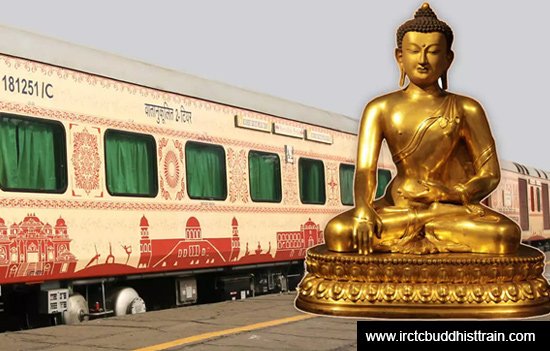 The Buddhist Circuit Tourist Train travel gives two great experiences.
The Buddhist Circuit Tourist Train travel gives two great experiences.
One is that you get to walk the same earth where Gautam Buddha once lived. Second is that you don’t have to worry how to cover places spread out in Bihar and Uttar Pradesh and Nepal. It is a 7 day trip.
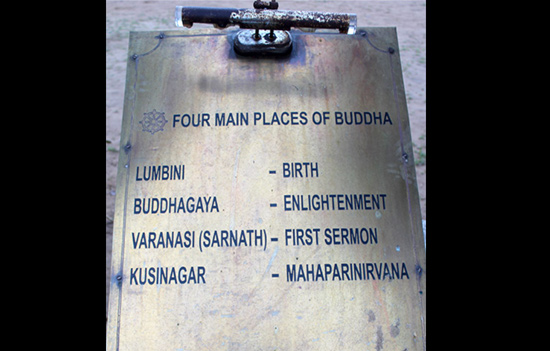
Travel experiences day-wise. To deep dive, Part 2 has Importance of each place.
We were a group of 35 travelers in a train that has a capacity of around 200 people, so were pampered! The train stops at each destination, and an AC bus, with a very accomplished guide, takes you to places on the day’s itinerary.
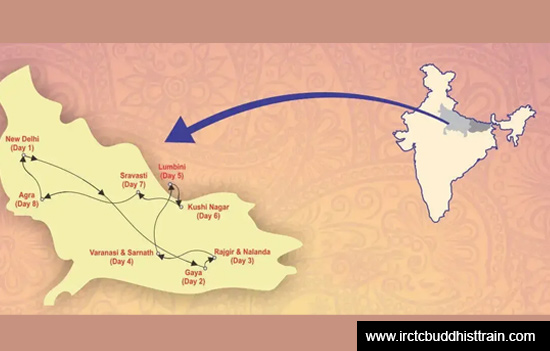
The day began with morning tea at 6 am followed by a
heavy breakfast at 7 am before setting out at 8 am. In some locations, we needed
to check-in into a hotel as sightseeing continues to the next day.
Most of the luggage can be left in one’s compartment on the train and only a backpack with a change of clothes and toiletries need to be carried. On the days there’s no overnight stay, short duration check-ins give one the comfort of a wash-up or relaxing time.
Lunch/high tea is served at the restaurants in these
hotels. On the day of longish bus travel, a snack box, in addition, is served
too. A
lot of sumptuous food daily!
We boarded the train at Safdarjung railway station in
the afternoon and alighted at Gaya the next morning. From there a bus directly
took us to Bodh Gaya where we checked-in into the Maha Bodhi hotel for an
overnight stay. Did a few temple visits that evening and some the next morning.
The train offers you end-to-end comfort and ultimate
ease of travel. The coaches are plush and the whole experience is very luxurious. You are well taken
care of, from the start to end of journey.
There’s a choice of different coaches-First and Second AC. The bio-vacuum toilets greatly reduce the requirement of water. A separate shower cubicle with an option of hot and cold water is available in each coach. There’s a fully-equipped pantry and kitchen aboard with an elaborate spread of menu for each meal, which is served in two restaurants with great ambience. There are well-equipped book shelves and foot massagers available too.
Everything is spotlessly clean throughout the journey as there’s dedicated support staff available 24*7 for each coach.
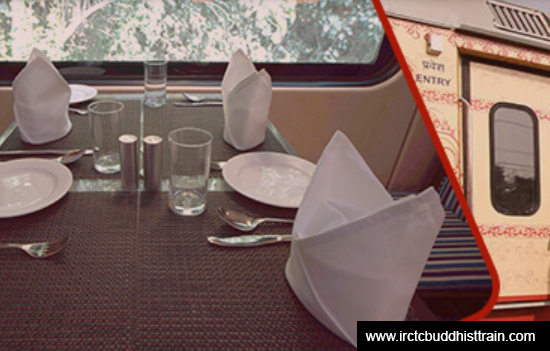 Dining
car.
Dining
car.
From Bodh Gaya we did a day trip to Rajgir and Nalanda
by bus and returned to our train that was parked at Gaya station. Dinner was
aboard the train and we moved on to Varanasi station where we de-boarded the
next morning after breakfast. A bus was waiting to take us to Sarnath and later
to the evening Ganga Aarti. In between, we checked-in into a hotel for a wash
up and lunch. Also a bit of shopping time was thrown-in.
Back on the train we left for Lumbini which is in Nepal. We alighted at Nautanwa the next morning,
which is the last railway station on the Indian side. We hopped on to our bus
which crossed the border at Sonauli in U.P. It is a simple security and
immigration process. However, it can take some time depending upon how many vehicles are ahead of you. No visa is required for Indians, just an ID check (only the passport and the voter ID work). For the rest it is visa on arrival at $30. It was just under an hour’s journey.
After checking-in into a hotel, we visited the Mayadevi
temple.
The next morning we drove down to Kushinagar which took around four hrs. There’s a lot to be explored in the town, so after lunch, we spent the rest of the day visiting different temples and stupas before we boarded the train at Gorakhpur.
Our next stop was Balrampur. This was where we
de-boarded for Shravasti, which was only a short drive from the station. At Shravasti we checked-in
into a hotel for a wash up and lunch before proceeding for a tour of the town.
We left from Balrampur for Agra that evening. It was a
longish overnight journey that got us to Agra (Tundla station) by late morning.
A leisurely visit to the Taj and a good meal at a restaurant followed.
After a relaxed tea and dinner on board, we reached Delhi on
a quieter train, full of thoughts, reminiscing the brilliant week that had just
gone by!
The hotels booked in all the cities were amongst the best the
place had to offer. Smooth check-ins, great food and very comfortable rooms.
During the trip, don’t forget to pick up some mouth-watering Tilkut in
Gaya and Khaja from Rajgir!
Part 2 Cultural Significance and History of each place given day wise
The present-day
Bihar, UP and Nepal is where Gautam Buddha lived for eighty years. I am blessed
to have been able to undertake this journey and returned richer knowing how
Siddhartha transformed into the Buddha.
I have tried to jot down how the trip unfolded for me
and hope this piece helps those who would wish to embark on a similar journey.
The write-up is
not in the chronology of different events in the life of Gautam Buddha but in
the sequence of how the IRCTC planned our itinerary.
Day 1 Bodh Gaya (Bihar)
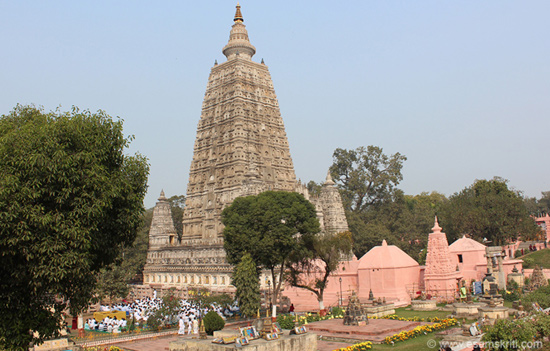 Bodh Gaya Temple.
Bodh Gaya Temple.
The Mahabodhi
Temple in Bodh Gaya lies 16 km from city of Gaya, on the banks of River Niranjana which
later joins River Mohana to form River Falgu that
flows through Gaya. It is one of the four holy sites related to the life of the
Lord Buddha, and is the place where the Buddha attained Enlightenment.
Emperor Ashoka built
a stupa which lasted 2nd century a.d. The original structure was
completed in the 7th century a.d. during the reign of the Gupta
kings. Turkish invaders destroyed the structure in 1205. A very thorough
renovation was started in 1874, completed by 1884.
Ashoka was the most ardent follower of Buddha
and it is he who built temples and stupas in almost every place of significance
that Buddha is connected with. The inscriptions in Pali on the Pillars erected
by him at different places have formed an important part of the documented
history that we read to day. Chinese travelers like Fa Hien and Hiuen Tsang
have recorded their observations in detail during their visits to these places.
One of the first temples to be built in burnt brick and
covered with stucco, it is a mix of North and South Indian styles of
architecture. A Kalash made of gold sits on top of the
temple Shikhar. The temple complex consists of the main shrine,
the Vajrasana or the Diamond Platform, the sacred Bodhi Tree and six other sacred sites related to Buddha’s early days of Enlightenment.
 Close up of Kalash.
Close up of Kalash.
Buddha attained Enlightenment under the Bodhi Tree, the
direct descendant of which stands at that place now. The Vajrasana is at the
exact spot under the Bodhi Tree where the Buddha would meditate. It was built
by Ashoka, and along with the Bodhi Tree, this spot is the holiest of all.
Buddha spent his First Week after Enlightenment under this tree.
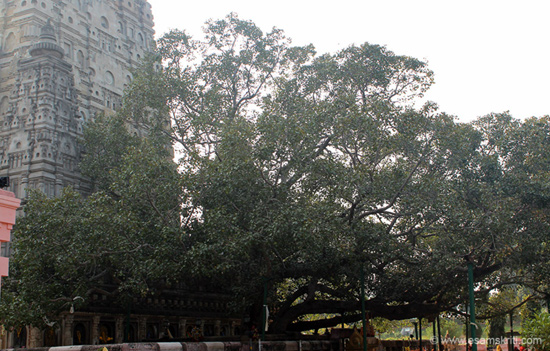 Bodhi
Tree.
Bodhi
Tree.
Close to the main shrine is Animeshlochan
Chaitya where Buddha is believed to have spent the Second Week gazing
uninterrupted at the Bodhi tree.
Chankramana marks the
spot where Buddha performed meditative perambulations in the Third Week after
his enlightenment. It is believed that wherever Buddha stepped, a lotus
bloomed. A raised structure with lotus flowers carved out of stone known as the
Jewel Promenade shrine, has been built here.
Ratanaghar Chaitya, also called the
Jewel House, is the place where Buddha spent the Fourth Week in meditation. A
ray of six colours is said to have emerged from his body during this time and
Buddhists have designed their flag in these colours.
Ajapala Nigrodha is where
Buddha spent the Fifth Week of meditation. A stone pillar standing at the spot
marks the banyan tree.
Muchalinda Sarovar is where
Buddha spent the Sixth Week after his enlightenment. It is believed that once
during meditation, a severe thunderstorm broke out and Buddha got badly
drenched. The serpent king called Muchalinda, spread his hood over Buddha to
protect him. A statue of Buddha with the hood of a snake above his head stands
here.
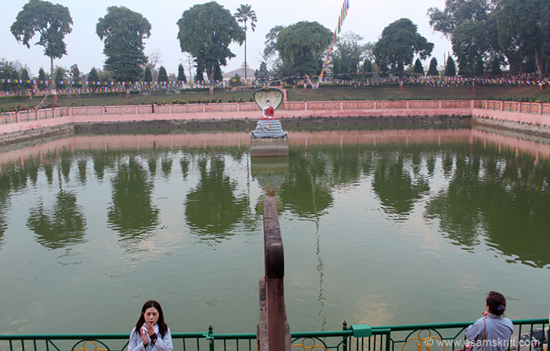 Muchalinda Sarovar.
Muchalinda Sarovar.
The Seventh Week was spent under the Rajyatana tree
and Buddha answered the queries of passersby here.
The temple has beautiful stone carvings of flowers,
geese and images of Buddha. In the
sanctum, is a gilded statue of the seated Buddha touching the earth in Bhumisparsh
Mudra. Near the main temple is a small shrine with a standing Buddha
at the back with his footprints or Padas carved in black
stone, dating from the 3rd century BC.
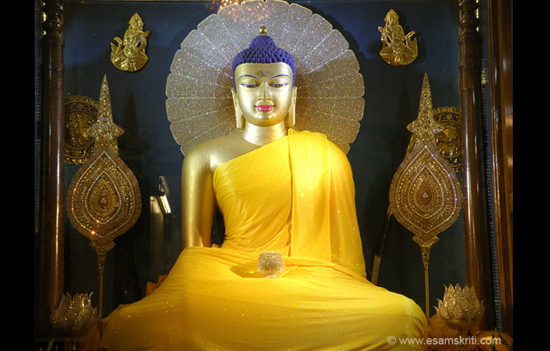 Inside temple.
Inside temple.
The complex has dozens of different types of stupas. One
can sit and pray at any of these places especially near the Bodhi Tree where
pilgrims meditate or chant mantras. One experiences complete bliss and divinity
all around.
Bodh Gaya has several beautiful temples and monasteries
built by different Buddhist nations across Asia for e.g. Myanmar, Thailand,
Japan, Cambodia, Sri Lanka.
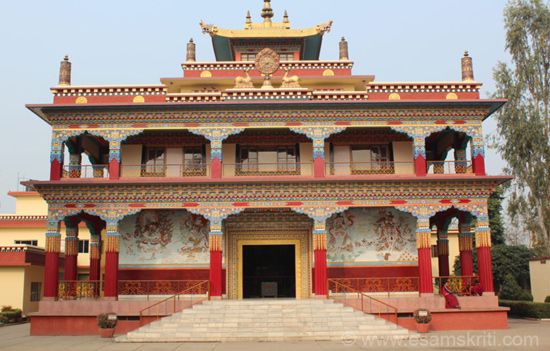 Tibetan temple.
Tibetan temple.
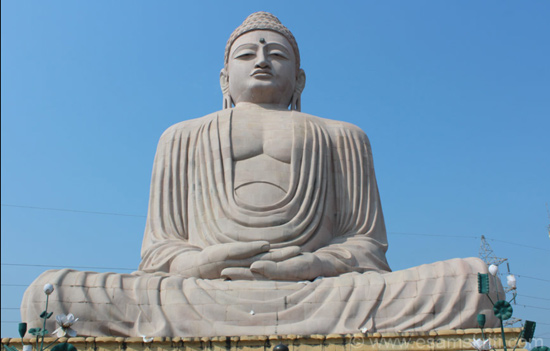 Great Buddha.
Great Buddha.
Day 2 Rajgir (Bihar)
Rajgir was the first capital of the ancient kingdom of Magadha State that eventually evolved into the Mauryan empire. It finds mention in India’s epic, the Mahabharata, through its king Jarasandha. Although the town’s date of origin is unknown, however, ceramic artifacts from around about 1000 BC have been found here. A huge 2,500-year-old Cyclopean wall still exists here which has been made just by interlocking stones.
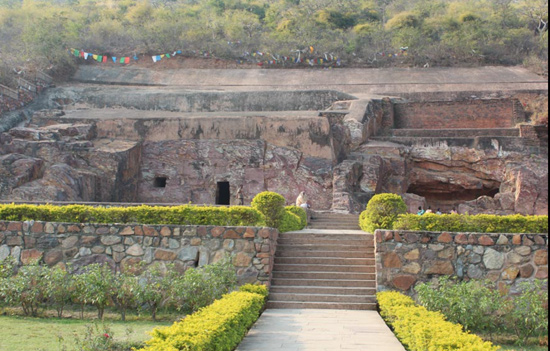 Son
Bhadra Cave was for Jain Sages. There
is supposed to be a king Bimbisara treasure inside which the British tried to
obtain, failed.
Son
Bhadra Cave was for Jain Sages. There
is supposed to be a king Bimbisara treasure inside which the British tried to
obtain, failed.
Bimbisara (558–491 BC) was the king of Rajgir and a contemporary of Buddha. His son Ajatshatru later kept him in captivity and announced himself as king. It is said that Bimbisara chose his place of captivity as from that place where he could see Buddha go up and down the Griddhakuta hill where he meditated. You can still see the Bimbisara jail ruins.
Gautama Buddha spent several months meditating and
preaching at Griddhakuta or the Vulture Peak. The peak is
called so because the rock is in the shape of a vulture. One can sense very
positive energy in the place, which is surrounded by hills. Buddha delivered
some of his famous sermons like the Lotus Sermon here. He also initiated
Bimbisara etc. to Buddhism at Rajgir.
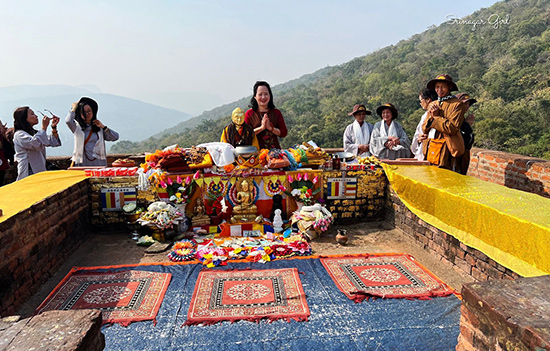 Vulture
Peak
Vulture
Peak
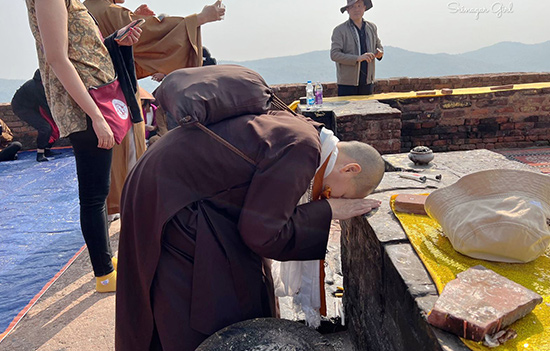
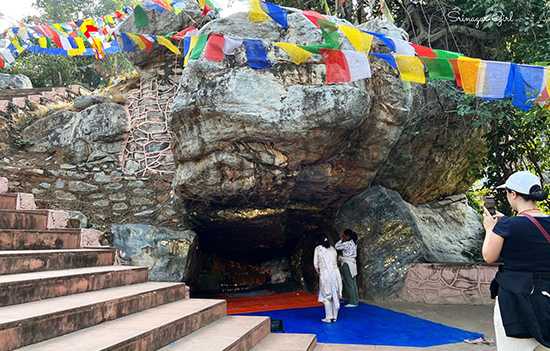 Sariputta’s cave.
Sariputta’s cave.
On the same hill, as you climb up, you first see the Ananda cave on your right and a little further is Sariputta’s cave. Both were Buddha’s disciples and meditated here. The Vulture Peak is further up from Sariputta’s cave.
On one of the hills called Songiri is
the Saptaparini Cave where the First Buddhist Council was
held under the monk Mahakassapa.
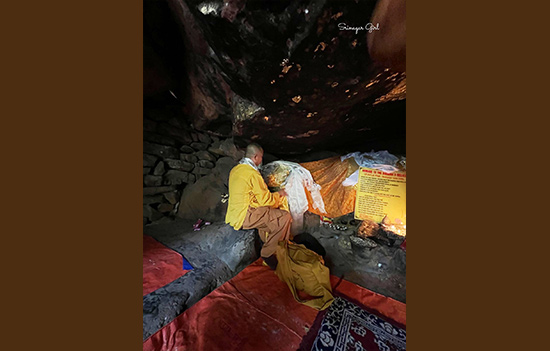 The Anand Cave.
The Anand Cave.
Nalanda Mahavihara
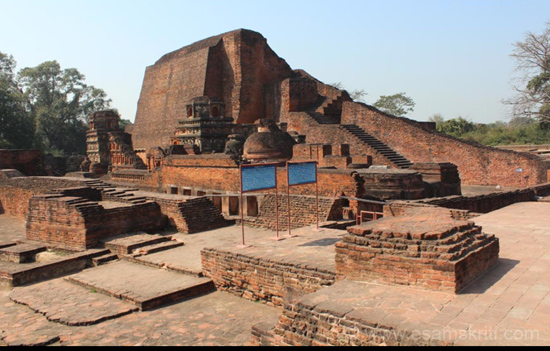 Main
Stupa.
Main
Stupa.
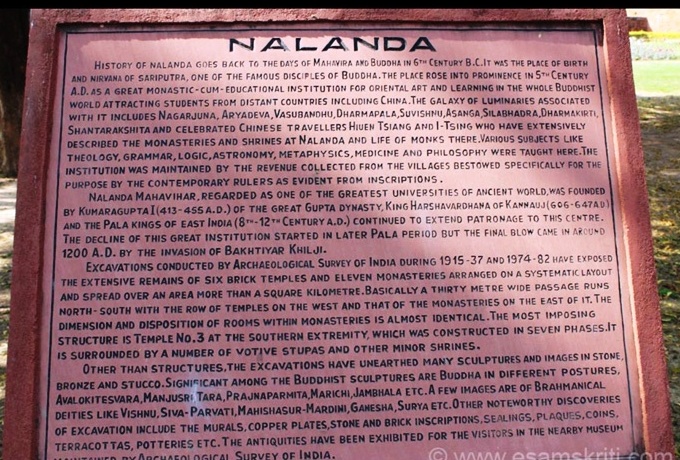 Board at Nalanda.
Board at Nalanda.
Nalanda was one of ancient India’s greatest cultural institutions. It flourished between 5th-12th centuries CE. The campus had many temples, stupas and monasteries where thousands of students lived and pursued various courses. Ruins of these structures can be seen even now as they have been properly preserved. It functioned as a prominent place of learning and was known for the sizeable number of monks who studied and taught there.
The Monastery no. 3 deserves a special mention. Although
there is no strong evidence but many Buddhist religious narratives attribute
the founding of this monastery to Ashoka. It is believed that it began as a
modest monastery and it is only in the 5th century CE that King Kumaragupta
established the university.
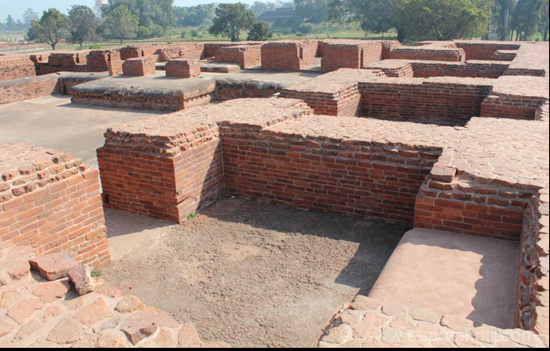 Monks quarters.
Monks quarters.
The future dynasties continued developing it further until
the Afghan military commander Bakhtiyar Khilji ransacked the university in 1193
CE. Do not miss the Nalanda
Museum which is definitely
worth a visit.
Day 3 Sarnath (Varanasi-Uttar Pradesh)
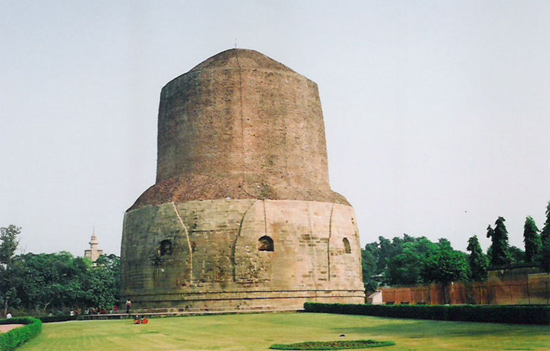 Sarnath Stupa.
Sarnath Stupa.
Sarnath is located 10 kms from Varanasi near the
confluence of the Asi and the Varuna rivers.
Sarnath is also known as Rishipatana, “the place where sages descend.” It is here in Mrigadava or
the Deer Park where the Shakyamuni, sage of the Shakya clan, gave his first
sermon. In 528 BCE Gautam Buddha, at age 35 and post attaining enlightenment,
delivered the sermon to his five companions (later followers)-Kaundinya,
Assaji, Bhaddiya, Vappa and Mahanama. It is also where the Buddhist Sangha first
came into existence.
One can see the Mulagandha Kuti – the quarters where the Buddha spent his days in Sarnath. The hut is called Mulagandha because a fragrant, flower-like smell always emanated from it. Hereafter, whichever hut he lived in, it always smelled fragrant and was called Gandhakuti!
STUPA
In this deer park, Ashoka built the 141 ft tall Dhamek Stupa
in 249 BCE at the spot where the Buddha delivered his First Sermon of Dharma
Chakra or Wheel Of Law to his five disciples.
The Chaukhandi Stupa in Sarnath (not within the Deer Park) was built as a terraced temple in the 7th or 8th century CE to commemorate the meeting of the Buddha with his five followers when he reached from Gaya to Sarnath. This stupa was later modified by Govardhan, the son of Todar Mal, by giving it an octagonal tower, to mark Humayun’s visit to Sarnath.
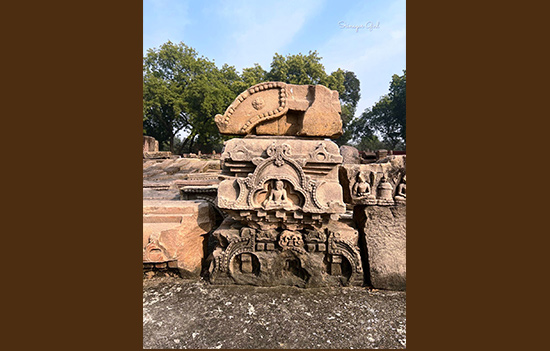
The park also houses the Ashoka Pillar (in three broken
parts). The exquisitely carved and highly polished Lion Capital made out of a
single block of sandstone, once stood attached to the top of this pillar. It is
now showcased in the museum outside the park. The Dharamchakra or
the Wheel of Law with its 32 spokes is also on display in the museum.
The national emblem of India is adopted from the Lion Capital of Ashoka at Sarnath. It features four Asiatic lions standing back to back, mounted on an abacus with a frieze carrying sculptures in high relief of an elephant, a galloping horse, a bull and a lion separated by intervening wheels over a bell-shaped lotus. At the bottom is a horse and a bull with the Dharma Chakra at the centre.
A visit to the museum is a must. It has some of
the most stunning sculptures of Buddha, Hindu Gods and other excavated artifacts.
Three main type of stupas are seen in all Buddhist sites, including this one — Uddeshika or Commemorative Stupa (in the memory of an event related to Buddha), Sariraka or Relic Stupa (containing the ashes of the Buddha), Paribhogika or Object Stupa (containing an object belonging to the Buddha).
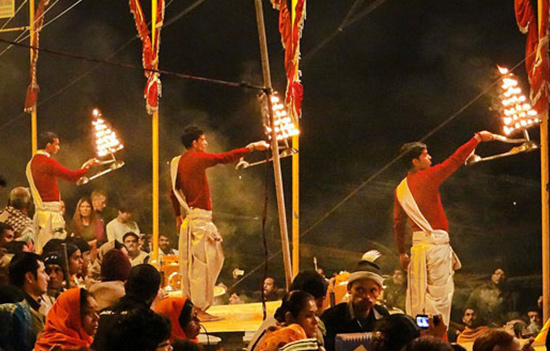
Although Ganga Aarti isn’t a part of the Buddhist track but when in Varanasi, one cannot miss praying to the Goddess, therefore, it is a part of the itinerary.
Day 4 Lumbini (Nepal)
Lumbini is in the Rupandehi district in Nepal. This is
where Queen Maya gave birth to Siddhartha around 566 BCE. His mother passed
away seven days later and thereafter his aunt Gautami raised him, so he was
known as Gautam as well.
 Mayadevi
Mandir.
Mayadevi
Mandir.
Lumbini has a number of old temples, the Mayadevi temple being the most significant one. It is in the middle of a huge park, which was once a Sal forest. Buddha’s mother, Mayadevi, was on her way from her home in Kapilavastu to her parents’ place in Devdaha, when she suffered labour pains. She stopped under a Sal tree, where she then took the ritual bath in a lotus pond next to it. Soon thereafter Siddhartha was born under this Sal tree. He too was given his first bath in the same pond.
The temple still has this sacred lotus pond (Pushkarini) next to it and a sacred
garden full of different trees around it.
The temple houses the birth-marker stone (in the shape of a human foot) and the nativity sculpture signifying Siddhartha’s birth at that spot. When Ashoka went to Lumbini around 249 BCE, he got a temple built of burnt bricks to safeguard the marker stone and the nativity sculpture. He also got an Ashoka Pillar erected at the back of the temple with an inscription in Pali of all the details recorded on it.
Day 5 Kushinagar (U.P.)
The ancient town of Kushinagar in Uttar Pradesh is named after Kush- the son of Lord Ram who founded and ruled the city. The archeological findings from the town go back to Ashoka’s time in 3rd century BCE.
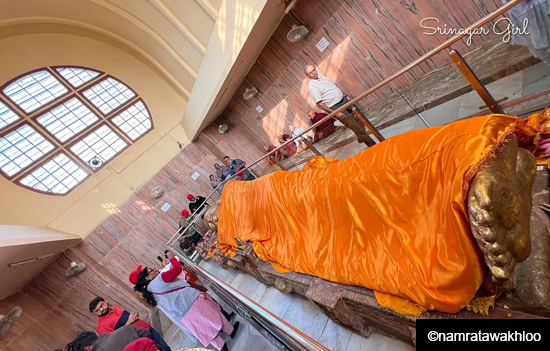 Resting Buddha.
Resting Buddha.
Kushinagar today is where Gautama Buddha attained
the Mahaparinirvana. After 45 years of preaching Buddha Vyakya,
the Buddha got severely sick with dysentery. He asked his disciple Ananda to
lay him down on a couch under two Sal trees, where he passed at the age of 80.
The Mahaparinirvana Temple houses an eighteen-foot long statue of reclining Buddha, positioned exactly as he lay when he passed, with his head to the north, on top of a couch. The statue dates back 1500 years to the Gupta period, and was sculpted from a red sandstone monolith, now gilted and wrapped in a saffron robe. On the stone couch, are carved three images of Buddha’s close followers who were probably at his side at the time of his passing. They are Vishakha, Ananda and Subhadra.
The temple and the statue were excavated by Alexander
Cunningham. The statue was found broken into numerous fragments, which were put
together carefully to create the original image.
Seven days after his Parinirvana, the mortal remains of the
Buddha were cremated at the Rambhar Stupa. The place is also known as Mukutbandhan
Chaitya.
Mathakaur Shrine in Kushinagar is where Lord Buddha gave his
last sermon before he died. The temple houses a 3m tall stunning statue of
Buddha, belonging to period 10th-11th century CE, carved from a
single block of bluestone brought from the Gaya region. The statue is in
the Bhumisparsh Mudra which depicts the last few moments of
his life just before he attained Nirvana.
Day 6 Shravasti (U.P.)
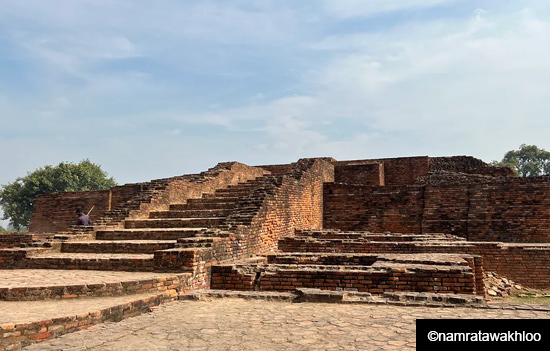 Kachi Kuti (made from sun-dried bricks) or Anantpindika Stupa.
Kachi Kuti (made from sun-dried bricks) or Anantpindika Stupa.
The Buddha first came to Shravasti at the request of
Sudatta (Anantapindika), a rich merchant. A beautiful grove was bought by
Sudatta from Jeta, son of King Prasenjit of Shravasti. He paid as many gold coins
to Jeta as it took him to cover the park. The park came to be known as Jetavana
Vihar.
Shravasti is where the Buddha gave most of his sermons. He spent twenty
five Varsha Vaas or rainy seasons in this region preaching.
The ruins in Shravasti have several temples and monasteries.
It has the quarters where the Buddha lived and those of his closest followers for
e.g. Ananda, Sariputta, Moggallena and Angulimaal.
Angulimaal deserves a special mention here. He was a blood
thirsty bandit who would wear a string of chopped fingers of his victims around
his neck, and after meeting the Buddha, he became one of his closest followers.
Later, by his divine powers he helped a helpless woman deliver a baby safely
and is considered by many Buddhists as the patron saint of fertility.
At Jetavana one can see the Anandbodhi tree. This tree is an
original descendant of the Mahabodhi tree at Bodh Gaya. It was planted by
Ananda for those followers of the Buddha who would get disappointed when they could
not see Buddha at Jetavana during his time away from there. They then sought
his blessings by praying under the tree. Many pilgrims still meditate under the
tree.
Shravasti has many outstanding temples built by many Asian countries, the oldest being the one made by Myanmar. This monastery has beautiful paintings on its walls that depict important events from the Buddha’s life.
It also houses his precious relics and we were fortunate to
have got a glimpse of it and seek his divine blessings.
Day 7 Agra
Although Agra is not connected with Buddhism a visit to the Taj Mahal is a part of the itinerary, probably thrown in to “add value” for the foreign tourist. The Buddhist Circuit is highly popular amongst Buddhists globally.
I would recommend this divine experience to all. The overall experience was outstanding. Indian Railways do a very good job.
To read all
articles by author
Also see albums
1. Nalanda University
2. Rajgir
3. Bodh Gaya Temple 1
4. Bodh Gaya Temple 2
5. Bodh Gaya Temple 3
6. Great Buddha Statue
7. New Nalanda University
8. Buddhist Caves Ellora
9. Sarnath
10. Sukhothai National Park,
Thailand
11. Ayutthaya Thailand
12. Kandy, Sri Lanka
13. Read about Gupta Empire
To read article with all pictures on
author blog Part
1 and Part
2 Article is copyright author. All pictures are copyright author and unless mentioned copyright www.esamskriti.com